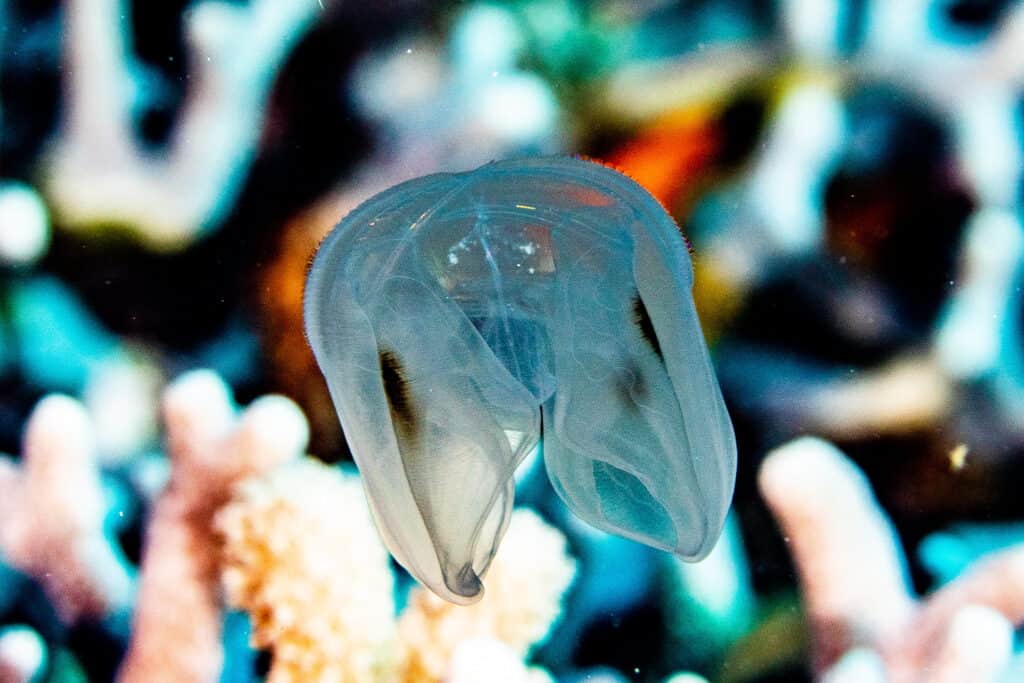Cozumel Jellyfish: Tips to Stay Safe and Avoid Injuries while Swimming and Snorkeling
Jellyfish are a common sight in the waters surrounding Cozumel, Mexico. While these creatures can be fascinating to observe, they can also pose a risk to swimmers and snorkelers. Understanding the jellyfish found in Cozumel and their behavior can help visitors stay safe while enjoying the island’s beautiful marine life.
Cozumel is home to several species of jellyfish, including the thimble jellyfish and the Spot-winged Comb Jelly, scientifically known as Leucothea pulchra. People most commonly find these creatures during the summer months, although sometimes you find them throughout the year. Visitors to Cozumel should know the risks associated with jellyfish stings and take precautions to avoid contact with these creatures.
If you plan on diving or snorkeling in Cozumel, it’s important to be prepared for the possibility of encountering jellyfish. This may include wearing protective clothing, such as a wetsuit or rash guard, and carrying a first aid kit with vinegar or other sting remedies. By taking these steps, you can minimize your risk of a painful or dangerous encounter with these fascinating creatures.
Key Takeaways
Cozumel is home to several species of jellyfish, including the thimble jellyfish and the Spot-winged Comb Jelly.
Visitors to Cozumel should know the risks associated with jellyfish stings and take precautions to avoid contact with these creatures.
If you plan on diving or snorkeling in Cozumel, it’s important to be prepared for the possibility of encountering jellyfish.
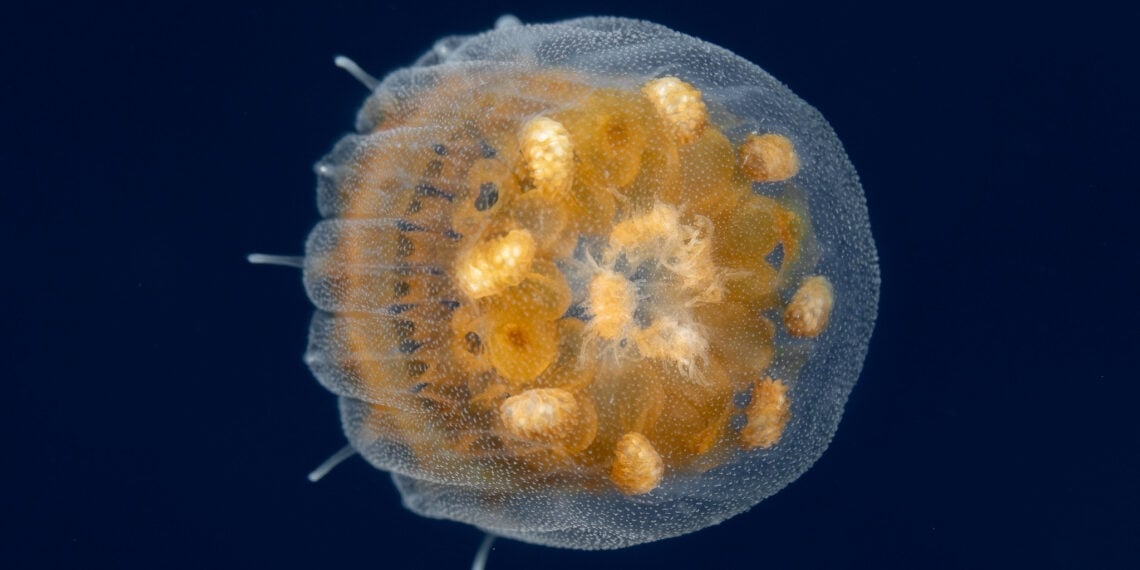
Understanding Jellyfish in Cozumel
If you’re planning to snorkel or swim in Cozumel, it’s important to understand the different species of jellyfish that inhabit the waters. Here’s what you need to know:
Species of Jellyfish
Cozumel is home to several species of jellyfish, including the thimble jellyfish and the Spot-winged Comb Jelly.
The thimble jellyfish, also known as sea lice or Linuche unguiculata, is a small, transparent jellyfish that can cause skin inflammation, burning, and stinging. These jellyfish are small, measuring about 1 inch in diameter, and are identifiable by their circular shape and brown markings.
The Spot-winged Comb Jelly, scientifically known as Leucothea pulchra, is a mesmerizing marine creature found primarily in deep ocean waters. Characterized by its translucent, gelatinous body adorned with distinctive spots and wings that resemble delicate lace, this comb jelly navigates the depths with grace. Spot-winged Comb Jellyfish, unlike their sting-bearing counterparts, are harmless to humans. They lack stinging cells, known as nematocysts, which are common in many other jellyfish species. Therefore, coming into contact with a Spot-winged Comb Jellyfish rarely results in any adverse effects or symptoms for humans.
However, it’s essential to exercise caution and avoid handling any marine creatures unless you’re certain of their harmlessness, as misidentification can lead to unintended consequences.
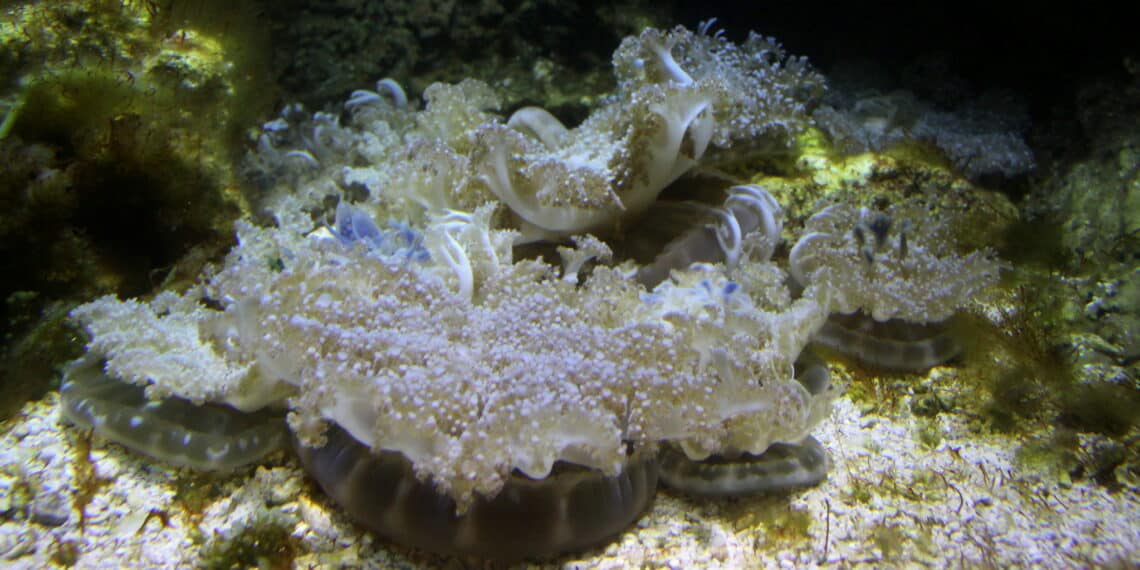
Upside-Down Jellyfish of Cozumel
Welcome to the captivating mangroves of Cozumel, where nature unveils its hidden treasures as a vibrant underwater spectacle. As seasoned explorers, we’ve had the privilege of delving into the depths of these mangroves and stumbling upon a mesmerizing sight. This colorful carpet resembles a bed of underwater flowers. But don’t let its delicate appearance fool you, for within this captivating display lies one of Cozumel’s well-kept secrets, the Upside-Down Jellyfish, scientifically known as Cassiopeia, or affectionately referred to as Xamachana or Upside-Down Mangrove Jellyfish.
These intriguing creatures are not solitary beings; rather, they form intricate communities, using the concave depression of their bells to adhere to the mangrove floor. This communal behavior ensures their proximity to one another, creating a stunning spectacle for those fortunate enough to witness it. Despite their ethereal appearance, upside-down jellyfish can grow to the size of a pie plate, boasting a composition that is predominantly water, with traces of salt and protein.
Within the mangroves, these jellyfish find sanctuary and sustenance. Acting as a nurturing haven for various marine life forms, mangroves offer not only protection but also an abundant food source. Rich in nutrients carried by sea currents, the mangrove waters become a feeding ground for drifting plankton, a delicacy captured by the upside-down jellyfish.
Remarkably, these jellyfish can cultivate their sustenance within their tentacles. The vibrant hues adorning their tentacles are not merely for show; they house algae and microscopic plants. By positioning themselves upside down, these jellyfish expose their tentacles to sunlight, allowing the algae to undergo photosynthesis. In this symbiotic dance, the algae nourishes the jellyfish, while the jellyfish’s stinging cells protect their photosynthetic companions.
Yet, amidst this harmonious ecosystem, predators lurk. Sea turtles, renowned inhabitants of Cozumel’s waters, consider the upside-down jellyfish a delectable feast. Additionally, jelly-eating fish such as tuna and sunfish are among the jellyfish’s natural adversaries, posing a constant threat to their existence.
In the enchanting realm of Cozumel’s mangroves, the intricate dance of life unfolds, weaving together a tapestry of beauty and survival. As we navigate through these waters, let us marvel at the resilience and interconnectedness of nature’s creations, where every creature plays a vital role in the delicate balance of the ecosystem.
Habitats and Behavior
Jellyfish inhabit all the world’s oceans, but they thrive, especially in the warm waters of the Caribbean. Jellyfish inhabit a variety of habitats, ranging from the surface of the water to the ocean floor. Some species of jellyfish follow ocean currents, which can make them more prevalent in certain areas at certain times of the year.
Jellyfish in Cozumel, including thimble jellyfish, are not aggressive towards humans and do not actively seek human contact. Instead, they spend most of their six-month lifespan floating near the surface in groups, feeding on plankton and algae. Sea turtles, spadefish, and sunfish consider thimble jellyfish a delicacy, and they are their largest predators.
Seasonal Patterns
Jellyfish populations in Cozumel fluctuate seasonally. While there is no specific jellyfish season in Cozumel, sightings are more common between March and July. During this time, currents and ocean tides may bring jellyfish closer to the shore. Sea turtle laying season coincides with the appearance of jellyfish because jellyfish provide a rich food source that attracts these creatures.
Diving and Snorkeling with Jellyfish
Jellyfish sightings are common while diving and snorkeling in Cozumel. While most jellyfish species are harmless, some can cause painful stings and skin irritation. In this section, we will discuss safety precautions, first aid for jellyfish stings, and the best times for jellyfish encounters.
Potential Risks and Precautions
While encounters with jellyfish in Cozumel are generally harmless, it’s important to be aware of potential risks and take necessary precautions to minimize any discomfort or irritation. Here are some key measures you can take:
Protective Clothing
Wearing protective clothing, such as rash guards or t-shirts, can act as a barrier between your skin and jellyfish tentacles. These garments can reduce the risk of accidental contact and provide an added layer of protection.
Sunscreen Selection
Choosing the right sunscreen can also help protect against jellyfish stings. Seek sunscreens labeled as “sea safe” or ones that create a protective barrier on the skin. These types of sunscreen can prevent jellyfish’s tentacles from coming into direct contact with your skin.
Avoiding Contact
While it may be tempting to touch or interact with jellyfish, it’s best to avoid any direct contact. Admire these creatures from a safe distance and resist the urge to handle them. Remember, it’s their natural habitat, and interfering with their behavior can be harmful to both you and the jellyfish.
Proper Response to Stings
In the event of a jellyfish sting, it’s important to respond appropriately to minimize any discomfort or potential allergic reactions. If you come into contact with a jellyfish, follow these steps:
Rinse the affected area with seawater immediately. Avoid using fresh water, as it can activate more stinging cells and worsen the situation.
Next, rinse the affected area with vinegar to neutralize the stingers and prevent further envenomation.
Do not rub or scratch the area. Rubbing or scratching the sting area can activate more stinging cells and prolong the discomfort. Apply a cold compress to reduce pain and swelling.
Seek medical attention if necessary: If the irritation persists or the sting area becomes severely affected, it’s advisable to seek medical attention. A healthcare professional can provide treatment based on the severity of the sting.
Additional Safety Tips
Here are a few additional tips to ensure your safety while enjoying the waters of Cozumel:
Stay informed: Keep an eye out for local advisories or signs indicating jellyfish. Stay updated on the current conditions and take necessary precautions accordingly.
Swim in designated areas: Authorities often monitor designated areas for potential hazards, including jellyfish.
Be cautious in shallow waters: While jellyfish sightings are less common in shallow waters, it’s still important to be cautious. Shuffle your feet along the sandy bottom to avoid accidentally stepping on any hidden marine life.
Use water shoes: Wearing water shoes can provide an extra layer of protection against potential jellyfish encounters, particularly in areas where they are more prevalent.
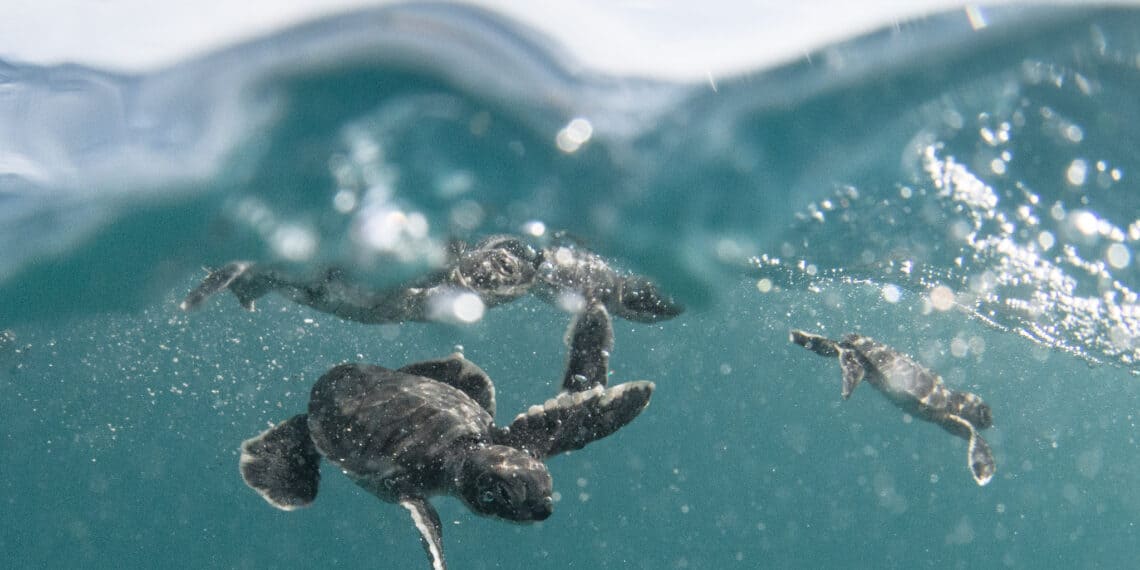
Cozumel Marine Life Beyond Jellyfish
Cozumel is home to a diverse range of marine life that extends beyond jellyfish. This beautiful island is the second-largest barrier reef in the world, and it is home to an abundance of marine species in hundreds of forms, species, and colors. Here are some of the marine creatures you can expect to see when you visit Cozumel.
Coral Reefs and Fish
Cozumel’s coral reefs are breathtakingly beautiful and are home to a vast array of fish species. You can see schools of colorful fish, including angelfish, parrotfish, and damselfish, darting in and out of the coral. If you’re fortunate, you may even spot an eagle ray or an eel hiding in the coral.
Sea Turtles and Their Conservation
Cozumel is also home to several species of sea turtles, including the green sea turtle, loggerhead sea turtle, and hawksbill sea turtle. These magnificent creatures are an essential part of the marine ecosystem, and Cozumel has several conservation programs in place to protect them. You can learn more about these programs and even participate in a sea turtle release when you visit Cozumel.
Unique Marine Creatures
Cozumel is also home to several unique marine creatures, including stingrays and octopuses. You can see these fascinating creatures, which are incredibly intelligent, gliding gracefully through the water. If you’re lucky, you may even spot a seahorse or a giant clam during your visit to Cozumel.
In conclusion, Cozumel is a paradise for marine life enthusiasts. From the colorful fish and coral reefs to the sea turtles and unique marine creatures, there is something for everyone to enjoy. So, grab your snorkel gear and explore the underwater world of Cozumel!
Practical Information for Visitors
Best Dive Sites in Cozumel
Cozumel is a world-renowned destination for scuba diving, with many dive sites to choose from. Some of the best dive sites in Cozumel include Palancar Reef, Santa Rosa Wall, and Punta Sur. Palancar Reef earns its reputation for its colorful coral formations and diverse marine life, while Santa Rosa Wall becomes famous for its steep drop-offs and strong currents. Punta Sur, on the southern tip of the island, is a great spot for drift diving and offers a chance to see larger marine creatures such as sharks and rays.
Travel and Accommodation
Getting to Cozumel is easy, with regular ferry services from Playa del Carmen on the mainland. There are also direct flights to Cozumel International Airport from several cities in the US and Mexico. Accommodation options on the island range from budget-friendly hostels to luxury resorts, with something to suit every budget and taste.
Local Attractions and Activities
Besides scuba diving, there are plenty of other activities and attractions to enjoy in Cozumel. Adventure parks such as Chankanaab and Xcaret offer zip lining, snorkeling, and other outdoor activities, while beach clubs such as Mr. Sancho’s and Paradise Beach offer a relaxing day in the sun. Don’t miss the opportunity to explore the island’s rich history and culture, with visits to landmarks such as San Gervasio Mayan Ruins and the Cozumel Museum.
When planning your visit to Cozumel, it’s important to keep in mind the weather. The island has a tropical climate, with warm temperatures year-round and occasional rain showers. The best time to visit is from December to April, when the weather is dry and sunny. However, this is also the busiest time of year, so be sure to book your accommodation and activities in advance.
Overall, Cozumel is a fantastic destination for anyone seeking a tropical getaway with plenty of adventure and relaxation. With its beautiful beaches, world-class diving, and rich culture, there’s something for everyone to enjoy.
Environmental Conditions and Their Effects
Seasonal Weather Patterns
The seasonal weather patterns influence Cozumel jellyfish in the area. During the hot summer months, the water temperature rises, and the sun’s rays penetrate the water, providing the perfect conditions for jellyfish to thrive. However, during the cooler winter months, the water temperature drops, and the jellyfish population declines.
Ocean Currents and Water Clarity
Ocean currents play a significant role in the distribution and movement of Cozumel jellyfish. Warm ocean currents, such as the Gulf Stream, bring jellyfish into the area, while cold ocean currents, such as the Labrador Current, push them out. Water clarity also affects the jellyfish population. Murky water can make it difficult for jellyfish to find food, while clear water can make it easier.
Impact of Human Activity
Human activity can have a significant impact on the Cozumel jellyfish population. Pollution and climate change can alter the water’s temperature, oxygen levels, and acidity, affecting the jellyfish’s ability to survive and reproduce. Overfishing can reduce the jellyfish’s natural predators, allowing their population to grow unchecked.
Overall, understanding the environmental conditions that affect Cozumel jellyfish is crucial for managing their population and ensuring their survival. By monitoring the water temperature, ocean currents, and human activity in the area, we can better understand how we can protect these fascinating creatures.
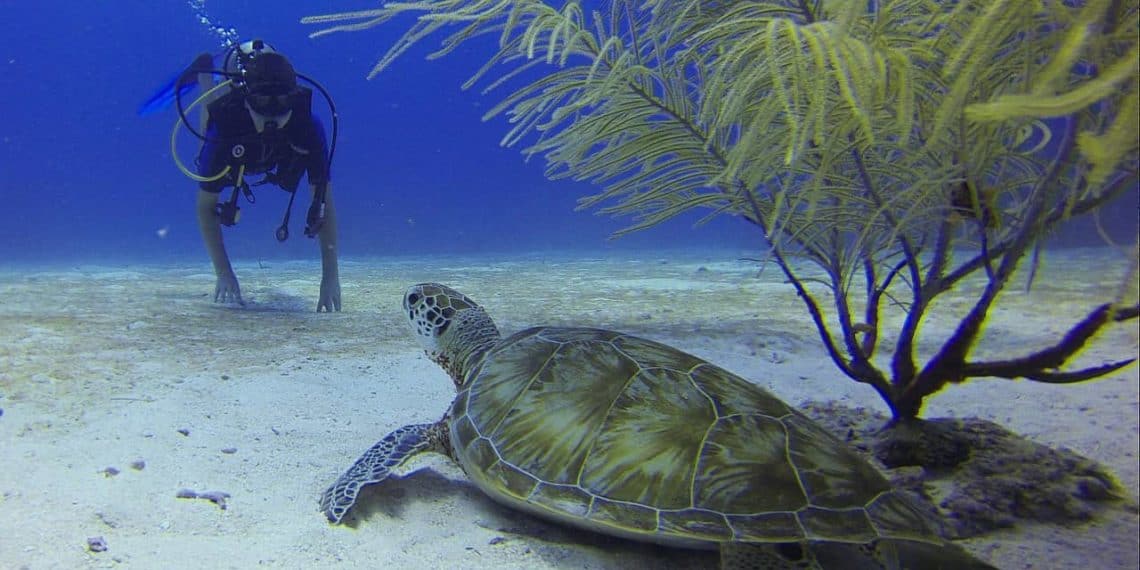
Community and Culture in Cozumel
Cozumel is a vibrant community with a rich culture that is reflected in its events, traditions, and conservation efforts. Here are some insights into the local community and culture that you might find interesting.
Conservation Efforts and Organizations
Cozumel is home to several organizations that are dedicated to conserving the island’s natural resources, including its marine life. One such organization is CAMAR, which is a local initiative that aims to promote sustainable tourism and protect the island’s environment. The group organizes beach cleanups, recycling programs, and other initiatives that help to keep the island clean and healthy.
Local Events and Festivities
Cozumel’s lively events and festivities, which reflect the island’s rich cultural heritage, have gained widespread recognition. Some of the most popular events include the annual Carnival, which occurs in February or early March and features colorful parades, music, and dancing. Other events include the Day of the Dead, which is celebrated in November and honors the memory of loved ones who have passed away, and the Feast of Our Lady of Guadalupe, which is a religious festival that occurs in December.
Cultural Insights
Its food, music, and traditions reflect the melting pot of different cultures in Cozumel. One of the most interesting cultural insights is the role of the traditional Mexican mother-in-law, or suegra, in family life. In Mexican culture, people often view the mother-in-law as a second mother and she plays a significant role in family dynamics. Another cultural insight is the popularity of rescue dogs on the island. Many locals adopt stray dogs and give them a loving home, which has led to a thriving community of dog lovers on the island.
Overall, Cozumel is a fascinating place that is full of culture, history, and natural beauty. Whether you are interested in conservation, local events, or cultural insights, there is something for everyone to discover on this beautiful island.
Frequently Asked Questions
If you get stung by a jellyfish in Cozumel, the first thing you should do is rinse the affected area with vinegar. This will help to neutralize the toxins and ease the pain. After rinsing with vinegar, you can apply a topical treatment to reduce the pain and swelling. Over-the-counter pain relievers like ibuprofen or acetaminophen can also help to relieve the pain.
The most common species of jellyfish found around Cozumel are the thimble jellyfish (Linuche unguiculata) and the moon jellyfish (Aurelia aurita). Thimble jellyfish typically inhabit shallow waters and can cause skin irritation and itching. The moon jellyfish are larger and have a mild sting that is not usually harmful to humans.
You can find images and descriptions of Cozumel jellyfish online or in local guidebooks. It is important to identify the different species of jellyfish in order to avoid any potential hazards.
The jellyfish population in Cozumel can vary throughout the year, but it is at its peak between March and July. During this time, it is important to be cautious when swimming or snorkeling in the ocean and to avoid touching any marine life.


